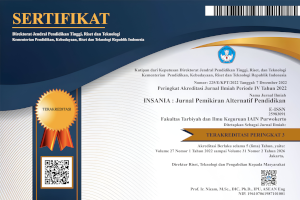Dongeng sebagai Desain Bahan Ajar Kreatif Bagi Anak Usia Dini (AUD) untuk Mengembangkan Kecerdasan Jamak (Multiple Intelligences)
DOI:
https://doi.org/10.24090/insania.v21i2.1412Keywords:
Story telling, creative teaching materials, plural intelligenceAbstract
Abstract: Education at schools are often more concerned with the cognitive aspect. Teachers, parents, and society in general in still view that intellegence is limited academic skills (logical-mathematical). There’s paradigm that the smart kid is who get high scores and rank top in the class. The paradigm is too narrow if reviewed at the other intellegences in the nature of human beings. Howard Gardner says that man has eight intelligences that can be developed well through approriate direction (learning). There are linguistic, logical-mathematical, spatial, kinesthetic, musical, interpersonal, intrapersonal, and naturalist intellegence.Summarizes the various aspects required in the process of development of intellegence such as language (linguistic), the storyline (the logic of the story), social sensitivity (interpersonal and intrapersonal), conflict (the rhythm), imagination (visual/spatial), movement (kinesthetic), and nature (naturalist). Teachers can pack the teaching materials to be attractive to the fairy tale, that is expected to be easily grasped by children, so that the potential intellegence of nature child can be optimally developed. Keyword: Story telling, creative teaching materials, plural intelligence.Downloads
References
Asfandiyar, Andi Yudha. 2007. Cara Pintar Mendongeng. Jakarta: DAR! Mizan
Aunurrrahman. 2010. Belajar dan Pembelajaran. Bandung: Alfabeta
Hapsari, Melati Ismi. 2013. “Story Telling dan Perkembangan Psikologi Anak Usia Diniâ€. Makalah disajikan dalam Seminar Nasional Membangun Karakter Bangsa melalui Sastra Anak yang diselenggarakan oleh Fakultas Sastra Universitas Muhammadiyah Purwokerto, 18 Desember 2013.
Jindrich, Susan. 2005. How to Help Children Learn. Yogyakarta: Book Marks
Gardner, Howard. 2013. Multiple Intelligences. Diterjemahkan oleh: Yelvi Andri Zainur. Jakarta: Daras Book.
Kemendikbud. 2013. Dokumen Kurikulum 2013
Komalasari, Kokom. 2011. Pembelajaran Kontekstual. Bandung: Refika Aditama
Kurniawan, Heru. 2013. Keajaiban Mendongeng. Jakarta: Bhuana Ilmu Populer
Kurniawan, Heru. 2014. Pembelajaran Menulis Kreatif. Bandung: Rosda Karya
Sagala, Syaiful. 2011. Konsep dan Makna Pembelajaran. Bandung: Alfabeta
Subekti. Fitrianto Eko. 2013. Pengembangan Bahan Ajar. (Diktat Mata Kuliah Pengembangan Bahan Ajar, Universitas Muhammadiyah Purwkerto)
Uno, Hamzah B. 2008. Perencanaan Pembelajaran. Jakarta: Bumi Aksara
Published
How to Cite
Issue
Section
License
Authors who publish with this journal agree to the following terms:
Authors retain copyright and grant the journal right of first publication with the work simultaneously licensed under a Creative CommonsAttribution-ShareAlike License that allows others to share the work with an acknowledgment of the work's authorship and initial publication in this journal.
Authors are able to enter into separate, additional contractual arrangements for the non-exclusive distribution of the journal's published version of the work (e.g., post it to an institutional repository or publish it in a book), with an acknowledgment of its initial publication in this journal.
Authors are permitted and encouraged to post their work online (e.g., in institutional repositories or on their website) prior to and during the submission process, as it can lead to productive exchanges, as well as earlier and greater citation of published work (See The Effect of Open Access).








